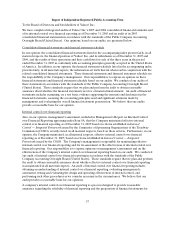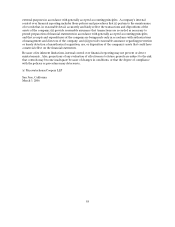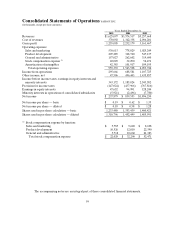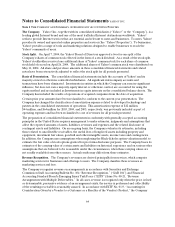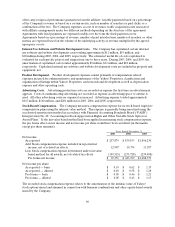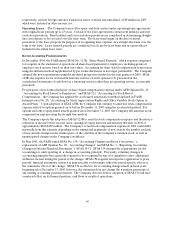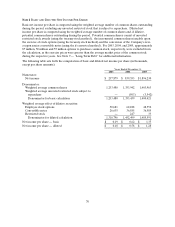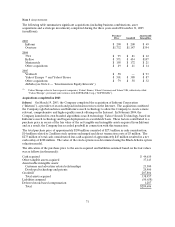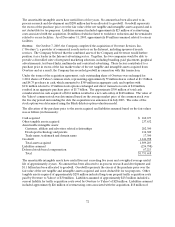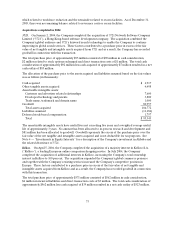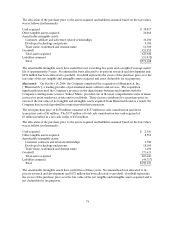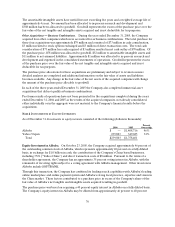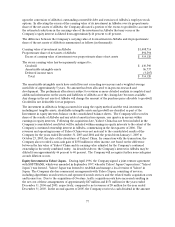Yahoo 2005 Annual Report Download - page 73
Download and view the complete annual report
Please find page 73 of the 2005 Yahoo annual report below. You can navigate through the pages in the report by either clicking on the pages listed below, or by using the keyword search tool below to find specific information within the annual report.67
See Note 12 — “Employee Benefits” for the assumptions and methodology used to determine the fair
value of stock-based compensation.
See “Recent Accounting Pronouncements” below regarding the impact of the adoption of Statement of
Financial Accounting Standards (“SFAS”) No. 123R (“SFAS 123R”), “Share-Based Payment.”
Income Taxes. Deferred income taxes are determined based on the differences between the financial
reporting and tax bases of assets and liabilities and are measured using the currently enacted tax rates and
laws. The provision for income taxes comprises the Company’s current tax liability and change in deferred
income tax assets and liabilities. A valuation allowance is provided to reduce deferred income tax assets to
the amount that, based on available evidence, is more likely than not to be realized.
Comprehensive Income. Comprehensive income consists of two components, net income and other
comprehensive income (loss). Other comprehensive income (loss) refers to gains and losses that under
generally accepted accounting principles are recorded as an element of stockholders’ equity but are
excluded from net income. The Company’s other comprehensive income (loss) is comprised of foreign
currency translation adjustments and unrealized gains and losses on marketable securities categorized as
available-for-sale.
Cash and Cash Equivalents, Short and Long-Term Investments. The Company invests its excess cash in
debt instruments of the United States Government and its agencies and in high-quality corporate issuers
which are classified as marketable debt securities. All highly liquid investments with an original maturity
of three months or less are considered cash equivalents. Investments with effective maturities of less than
12 months from the balance sheet date are classified as current assets. Investments with effective
maturities greater than 12 months from the balance sheet date are classified as long-term assets.
The Company’s marketable debt and equity securities are classified as available-for-sale and are reported
at fair value, with unrealized gains and losses, net of tax, recorded in accumulated other comprehensive
income (loss). Realized gains or losses and declines in value judged to be other than temporary, if any, on
available-for-sale securities are reported in other income, net. The Company evaluates the investments
periodically for possible other-than-temporary impairment and reviews factors such as the length of time
and extent to which fair value has been below cost basis, the financial condition of the issuer and the
Company’s ability and intent to hold the investment for a period of time which may be sufficient for
anticipated recovery in market value. The Company records impairment charges equal to the amount that
the carrying value of its available-for-sale securities exceeds the estimated fair market value of the
securities as of the evaluation date, if appropriate. The fair value for securities is determined based on
quoted market prices as of the valuation date. In computing realized gains and losses on available-for-sale
securities, the Company determines cost based on amounts paid, including direct costs such as
commissions, to acquire the security using the specific identification method. During the year ended
December 31, 2005, realized gains and losses on available-for-sale debt securities were not material.
Investments in Equity Interests. Investments in entities in which the Company can exercise significant
influence but does not own a majority equity interest or otherwise control, are accounted for using the
equity method and included as Investments in equity interests on the consolidated balance sheets. The
Company records its share of the results of these companies one quarter in arrears within earnings in
equity interests on the consolidated statements of operations. The Company monitors its investments for
other-than-temporary impairment by considering factors including the stock price of public companies in
which it has an equity investment as well as current economic and market conditions and the operating
performance of the companies and records reductions in carrying values when necessary. The fair value of
privately held investments is estimated using the best available information as of the valuation date, including
current earnings trends, undiscounted cash flows, quoted stock prices of comparable public companies, and
other company specific information, including recent financing rounds.


